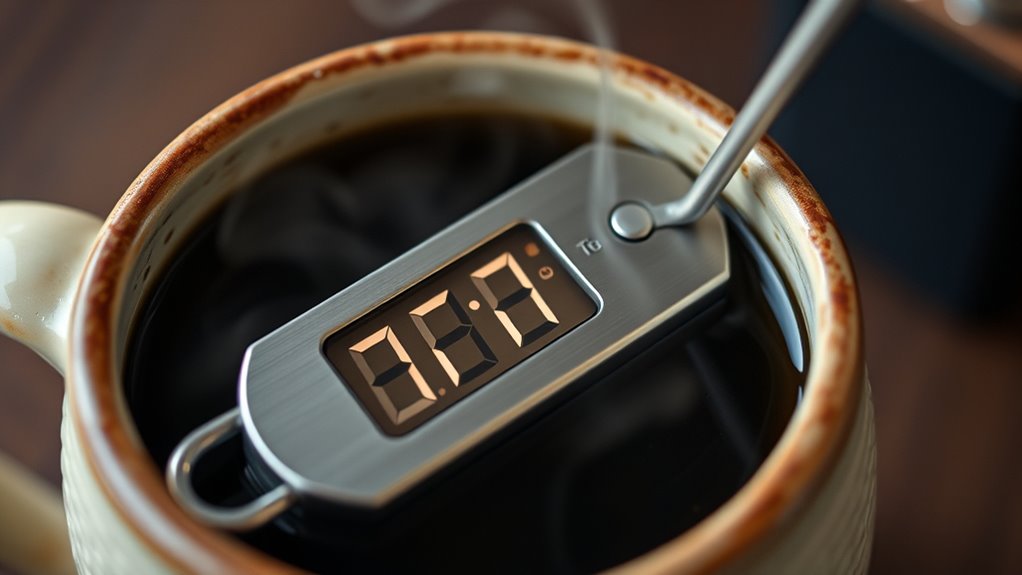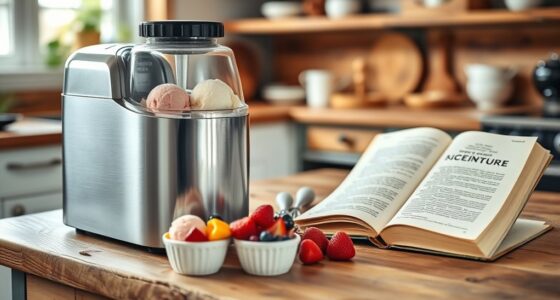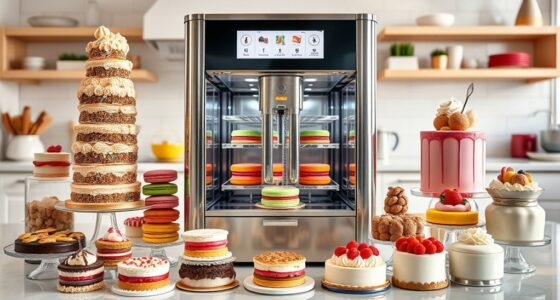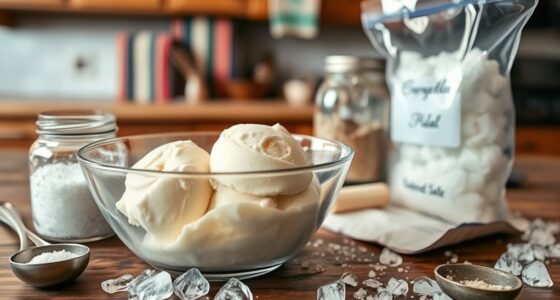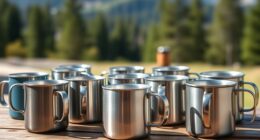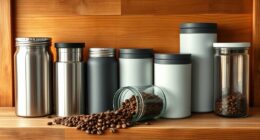Monitoring temperature with a coffee thermometer is key to brewing and roasting your perfect cup. Digital models give you quick, precise readings, while dial thermometers offer durability and simplicity. For roasting, choose high-heat-tolerant probes; for brewing, waterproof and quick-response thermometers work best. Matching your needs with the right type of thermometer guarantees consistent results. Keep an eye on features like calibration and maintenance—continue exploring to find out more about selecting the best thermometer for your coffee process.
Key Takeaways
- Choose digital thermometers for quick, accurate water and milk temperature readings during brewing and steaming.
- Use clip-on or gooseneck models for precise placement in pour-over or steaming processes.
- Ensure the thermometer’s temperature range matches coffee roasting (50-550°F) or brewing (100-212°F) needs.
- Regularly calibrate and clean thermometers for consistent, reliable temperature monitoring.
- Select waterproof or durable models suitable for brew stations to withstand moisture and frequent use.
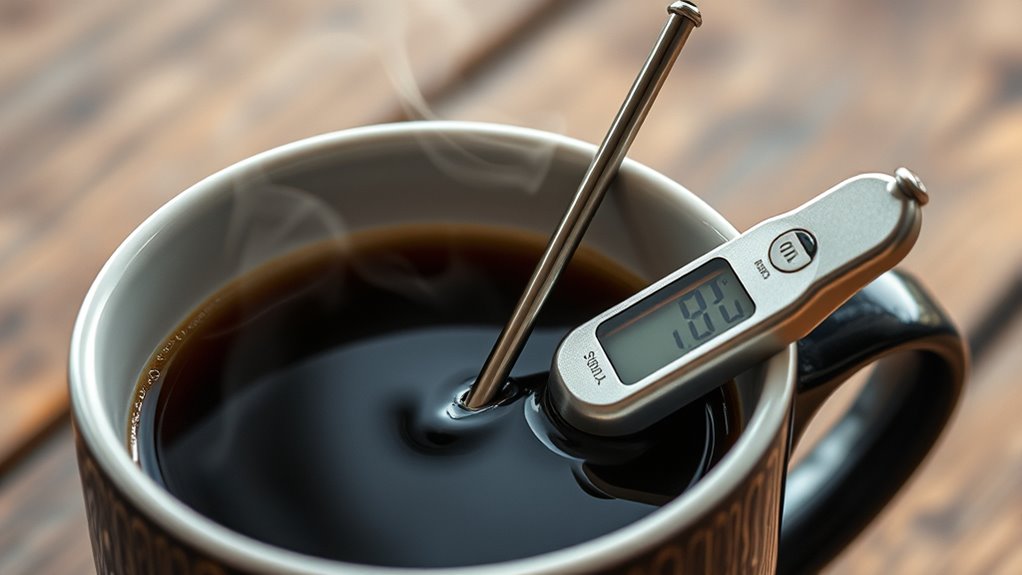
If you’re serious about brewing great coffee or roasting beans to perfection, having the right thermometer is vital. The type you choose will depend on your specific needs, whether it’s monitoring bean temperature during roasting or guaranteeing perfect water temperature during brewing.
Digital models are popular for their precision and real-time readings, often supporting Type K thermocouples, which are ideal for high-temperature roasting. They provide quick, accurate feedback, typically within 2 to 5 seconds, making them perfect for dynamic roasting environments.
Dial thermometers, on the other hand, feature mechanical designs with easy-to-read analog displays, offering visual simplicity that’s great for tracking temperature changes at a glance. These are often durable and don’t rely on batteries, making them reliable for long-term use.
Instant-read thermometers are versatile tools that excel at quick checks of water or brew temperatures during preparation. They’re compact, affordable, and respond rapidly, usually within seconds, which helps you fine-tune your brew or determine if your water has reached the ideal temperature.
Pocket-type thermometers, typically costing under $40, are especially handy for roasting beans or stovetop use, with probes around 5 inches long to reach deep into roasters or pots.
If you focus on milk steaming or frothing, specialized analog thermometers with clip-on functionality are designed for microfoam creation, usually measuring between 100 and 160°F to prevent overheating.
When selecting a thermometer, consider probe compatibility—Type K thermocouples are best for roasting, while shorter probes suit brewing. The temperature range should cover your application: 50-550°F for roasting, and 100-212°F for brewing.
The display type matters, too; digital screens offer high precision, whereas analog dials provide tactile feedback without power dependency. Durability features like waterproofing are essential for brew stations, while heat-resistant housings are fundamental for high-heat roasting environments.
Response time varies: instant-read models respond in seconds, whereas mechanical models can take longer but offer ongoing visual cues.
Price points range from budget models at $10 to $30, suitable for casual use, to mid-range digital units costing $20 to $50 with alarms and programming. For commercial-grade roasting, options exceeding $73 offer advanced features, including multiple probes and calibration options.
Probe costs are additional, often between $15 and $50, depending on compatibility and quality.
In your setup, use case scenarios influence your choice. Roasters need high-heat-tolerant probes, while brew stations benefit from waterproof, submerged probes. Milk steaming demands accurate, quick-response thermometers, and pour-over brewing works well with clip-on gooseneck-compatible models.
Proper calibration, probe placement, and maintenance are key to accuracy. Digital models typically hold calibration longer and are more precise, with error margins of about ±2°F, compared to ±5°F for analog options. Regular calibration and proper probe care are essential for consistent results.
Regular cleaning, calibration checks, and careful probe storage ensure consistent performance. By selecting the right thermometer for your needs, you’ll gain better control over your coffee process, resulting in consistently excellent brews and perfectly roasted beans.
Frequently Asked Questions
How Often Should I Calibrate My Coffee Thermometer?
You should calibrate your coffee thermometer regularly to guarantee accurate readings. For most thermometers, weekly or monthly calibration is recommended, especially if you notice inconsistent temperature measurements.
Digital thermometers with calibration features may require less frequent checks, but it’s still wise to verify periodically. Always follow the manufacturer’s instructions and document your calibration results.
If your thermometer is new or has been dropped, calibrate it immediately to maintain proper temperature control.
Can I Use a Food Thermometer for Coffee?
You might wonder if a food thermometer works for coffee, and the truth is, yes, it can. Many food thermometers, especially instant-read or digital models, measure temperatures within the ideal brewing range of 195°F to 205°F.
They’re practical, accurate, and easy to clean. Just make sure the thermometer has a suitable probe, a quick response, and covers the necessary temperature range to guarantee your coffee’s flavor stays perfect.
What’S the Ideal Temperature for Different Coffee Brewing Methods?
You’re asking about the ideal temperature for different brewing methods.
Generally, aim for 195°F to 205°F across methods like pour-over, drip, espresso, French press, and Moka pot.
Pour-over and drip brewing benefit from slightly higher temps to counter heat loss.
Espresso needs precise control within this range for flavor.
French press and Moka prefer higher temps for full extraction, ensuring rich flavors and aroma.
Are Digital Thermometers More Accurate Than Analog Ones?
You might find that digital thermometers are 95% more precise than analog ones, making them better for accurate measurements.
When you compare their stability, digital models maintain consistent readings over time, unlike analog thermometers that can drift due to calibration issues.
With quicker response times and clearer displays, digital thermometers give you more reliable and easy-to-read results, especially when precise temperature control is essential for brewing the perfect cup.
How Does Ambient Temperature Affect Coffee Temperature Monitoring?
Ambient temperature critically influences how you monitor coffee temperature because it affects the accuracy of your readings. When the environment is cold or hot, it can cause your thermometer to give false readings or make it harder to maintain consistent brew temperatures.
To guarantee precise monitoring, you should regularly calibrate your devices, keep equipment in stable conditions, and be aware of seasonal changes that might require adjustments in your process.
Conclusion
With coffee thermometers, you can confidently control the vital heat, ensuring perfect brews every time. By balancing best temperatures, you build better brews and boost your barista skills. Don’t dodge decisive details—diligently detect, determine, and deliver deliciously ideal drinks. Mastering measurements makes your mornings more magical and your mugs more magnificent. So, stay sharp, stay savvy, and savor the sensational satisfaction of superbly monitored, meticulously brewed coffee every single sip.
